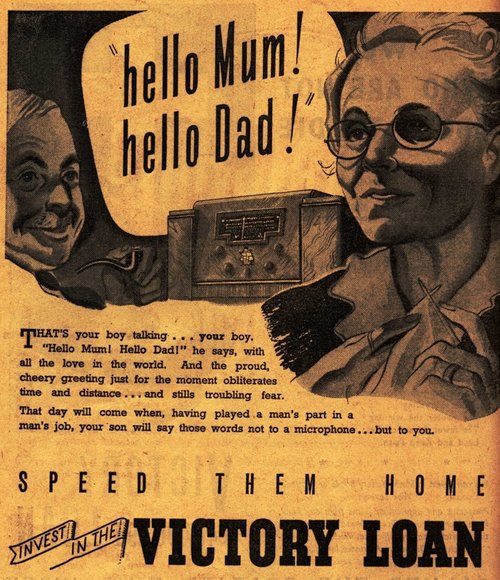
Hero image: Archibald Curry, NZ Broadcasting Unit, recording a message from a New Zealander on the Cassino Front, Italy. Photograph taken by George Bull. Alexander Turnbull Library, DA-05597-F.
During World War II, a Sunday morning radio programme became appointment listening in many households in Aotearoa New Zealand. With the Boys Overseas featured the voices of New Zealand armed forces personnel serving overseas. The recordings of their short greetings to whānau and friends back home, were made by the National Broadcasting Service mobile recording units, which travelled to North Africa, Italy and the Pacific with the New Zealanders.
Ngā Taonga Sound & Vision holds around 1,600 surviving 12-inch discs of these recordings, which form part of the Radio New Zealand sound archive. I am a sound history researcher and, with the support of Ngā Taonga, I am working my way through these wartime recordings, researching how they were produced and writing about what I hear.

Alexander Turnbull Library, DA-05602-F
Flight Sergeant Pat Newman of New Plymouth (at left), a New Zealander serving with the Royal Air Force near Cassino, Italy, records a message home with Arch Curry of the Broadcasting Unit, 1944. Photograph by George Bull.
The New Zealand Journal of Public History has just published my article about the reaction of home front radio listeners to the work of the overseas broadcasting units – and in particular, how the overwhelming public response to With the Boys Overseas influenced the work of the units from 1940-1945.
New Zealanders at home were excited by the novelty of being able to hear the voices of loved ones fighting on the other side of the world. In an era long before the internet - or even international telephone calls - letters and telegrams were the only way of keeping in touch, so to be able to hear your soldier son, husband or brother speaking over the radio, was understandably popular. The advertisement shown below for Victory Loans (a type of government war bond) illustrates wartime parents listening to their son speaking over the wireless.

Victory Loan advertisement, The Listener, 15 Sept 1944, p.4
Māori radio listeners were particularly keen to hear the voices of their men, and the article discusses possible reasons for this and how the broadcasting units responded to their need to hear more voices of the men of the 28 (Māori) Battalion.
The ongoing demand from Māori and Pākehā radio audiences to hear the greetings from their men overseas meant the mobile unit broadcasters had to keep recording and sending as many of the short greetings as they could, as well as reporting on the war and the part the New Zealand Division was playing in it.
The article examines how our first broadcasting war correspondents juggled these priorities. They covered military campaigns in Egypt, Libya, Italy, and the Pacific, with their reports often filed to the BBC in London, and then heard via the BBC’s Overseas Service on shortwave radio. They travelled with the New Zealand Division, enduring difficult conditions and coming under enemy fire on several occasions.

The New Zealand Broadcasting Unit in the Pacific, outside their ‘recording hut’
Circa 1943. L-R: Army driver Bill Laing, commentator-correspondent Vivian Spencer, engineer Don Cameron. Image courtesy of the Spencer family.
During World War II, radio was at the heart of most New Zealand homes (85% of households owned radios, the third highest rate in the world) and its role needs to be examined in order to fully understand our past. Our radio history is not often written about. As an “invisible” medium it is easy to ignore, and so often what is broadcast is heard once, and then simply disappears into the air and is lost forever. But I believe it is possible to find enough traces of our radio past to reconstruct the story of the vital role this medium played in the years before television arrived.
I am grateful to the families of several of the New Zealand Broadcasting Unit members who have shared their fathers’ letters and precious photographs with me and allowed these to be shared with the wider public. Thanks also goes to Ngā Taonga Sound & Vision and Radio New Zealand for their ongoing support in providing me with access to these audio taonga, and to the Judith Binney Trust and the Manatū Taonga Whiria te Mahara New Zealand History Grants for the initial funding to get my research off the ground.
The full NZJPH article can be read here . I also blog about my ongoing work at World War Voices.